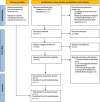Atrial fibrillation ablation compared to pacemaker therapy in patients with tachycardia-bradycardia syndrome: A systematic review and updated meta-analysis
- PMID: 38640303
- PMCID: PMC11030008
- DOI: 10.1097/MD.0000000000037543
Atrial fibrillation ablation compared to pacemaker therapy in patients with tachycardia-bradycardia syndrome: A systematic review and updated meta-analysis
Abstract
Background: Tachycardia-bradycardia syndrome (TBS) is a subtype of sick sinus syndrome characterized by prolonged sinus pause (≥3 s) following termination of tachyarrhythmias, primarily atrial fibrillation (AF). There is controversy regarding whether the long-term prognosis of AF ablation is superior to pacemaker implantation. This study aimed to compare the effects of AF ablation and pacemaker therapy in patients with TBS.
Methods: We conducted a comprehensive search of electronic databases, including PubMed, Cochrane, EmBase, Web of Science, and Chinese BioMedical, up until December 1, 2023. We included studies that reported the effects of AF ablation vs pacemaker therapy in patients with TBS. From this search, we identified 5 studies comprising 843 participants with TBS who underwent catheter AF ablation or pacemaker therapy.
Results: Our meta-analysis revealed that AF ablation and pacemaker therapy had similar effects on cardiovascular death (odds ratio [OR] = 0.62 and 95% confidence interval [CI]: 0.14-2.65), procedural complications (OR = 1.53 and 95% CI: 0.67-3.48), and cardiovascular rehospitalization (OR = 0.57 and 95% CI: 0.26-1.22). However, AF ablation provided greater benefits than pacemaker therapy in terms of all-cause mortality (OR = 0.37 and 95% CI: 0.17-0.82), thromboembolism (OR = 0.25 and 95% CI: 0.12-0.49), stroke (OR = 0.28 and 95% CI: 0.13-0.57), heart failure (OR = 0.27 and 95% CI: 0.13-0.56), freedom from AF (OR = 23.32 and 95% CI: 7.46-72.92), and prevention of progression to persistent AF (OR = 0.12 and 95% CI: 0.06-0.24). Furthermore, AF ablation resulted in a reduced need for antiarrhythmic agents (OR = 0.21 and 95% CI: 0.08-0.59).
Conclusion: AF ablation can effectively reduce the risk of all-cause mortality, thromboembolism, stroke, heart failure, and progression to persistent AF in patients with TBS. Additionally, it may eliminate the need for further pacemaker therapy in most cases after ablation. Therefore, AF ablation is considered superior to pacemaker therapy in the management of patients with TBS.
Copyright © 2024 the Author(s). Published by Wolters Kluwer Health, Inc.
Conflict of interest statement
The authors have no conflicts of interest to disclose.
Figures




References
-
- Clementy N, Andrade JG, Babuty D, et al. . Unusual tachycardia–bradycardia syndrome during atrial fibrillation: what is the mechanism? Circ Arrhythm Electrophysiol. 2013;6:e42–6. - PubMed
-
- Lo LW, Tuan TC, Tai CT, et al. . Incessant wide QRS tachycardia after pulmonary vein isolation and pacemaker implantation in a patient with tachycardia–bradycardia syndrome. J Cardiovasc Electrophysiol. 2007;18:783–4. - PubMed
-
- Kusumoto FM, Schoenfeld MH, Barrett C, et al. . 2018 ACC/AHA/HRS guideline on the evaluation and management of patients with bradycardia and cardiac conduction delay: a report of the American College of Cardiology/American Heart Association Task Force on Clinical Practice Guidelines and the Heart Rhythm Society. Circulation. 2019;140:e382–482. - PubMed
-
- Hocini M, Sanders P, Deisenhofer I, et al. . Reverse remodeling of sinus node function after catheter ablation of atrial fibrillation in patients with prolonged sinus pauses. Circulation. 2003;108:1172–5. - PubMed
Publication types
MeSH terms
LinkOut - more resources
Full Text Sources
Medical

